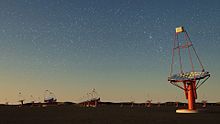
Cherenkov Telescope Array

The Cherenkov Telescope Array or CTA is a multinational, worldwide project to build a new generation ground-based gamma-ray instrument in the energy range extending from some tens of GeV to about 300 TeV. It is proposed as an open observatory and will consist of two arrays of Imaging Atmospheric Cherenkov telescopes (IACTs), a first array at the Northern Hemisphere with emphasis on the study of extragalactic objects at the lowest possible energies, and a second array at the Southern Hemisphere, which is to cover the full energy range and concentrate on galactic sources. The physics program of CTA goes beyond high energy astrophysics into cosmology and fundamental physics. The Cherenkov Telescope Array or CTA is a multinational, worldwide project to build a new generation ground-based gamma-ray instrument in the energy range extending from some tens of GeV to about 300 TeV. It is proposed as an open observatory and will consist of two arrays of Imaging Atmospheric Cherenkov telescopes (IACTs), a first array at the Northern Hemisphere with emphasis on the study of extragalactic objects at the lowest possible energies, and a second array at the Southern Hemisphere, which is to cover the full energy range and concentrate on galactic sources. The physics program of CTA goes beyond high energy astrophysics into cosmology and fundamental physics. Building on the technology of current generation ground-based gamma-ray detectors (MAGIC, HESS, and VERITAS), CTA will be ten times more sensitive and have unprecedented accuracy in its detection of high-energy gamma rays. Current gamma-ray telescope arrays host up to five individual telescopes, but CTA is designed to detect gamma rays over a larger area and a wider range of views with more than 100 telescopes located in the northern and southern hemispheres. At least three classes of telescopes are required to cover the full CTA energy range (20 GeV to 300 TeV): Large-Sized Telescope (LST), Medium-Sized Telescope (MST) and Small-Sized Telescope (SST). The project to build CTA is well-advanced: prototypes exist for all the proposed telescope designs and significant site characterization and preparations are underway. An inter-governmental agreement for construction and subsequent operation of the observatory, a European Research Infrastructure Consortium (ERIC), is in preparation and the financial threshold is expected to be reached in 2019. The project was promoted to a Landmark on the road-map of the European Strategy Forum on Research Infrastructures (ESFRI), and is on the roadmaps for the European Astroparticle Physics network ASPERA and the European Astrophysics network ASTRONET. Cost for base-line design of the project is estimated at €300 million (US$350 million). As of December 2018, the CTA Consortium includes more than 1,420 members from 210 institutes in 31 countries: Armenia, Australia, Austria, Brazil, Bulgaria, Canada, Chile, Croatia, Czech Republic, Finland, France, Germany, Greece, India, Ireland, Italy, Japan, Mexico, Namibia, Netherlands, Norway, Poland, Slovenia, South Africa, Spain, Sweden, Switzerland, Thailand, the United Kingdom, Ukraine and the United States. The group of scientists and engineers are engaged in the scientific and technical development of CTA. Its internal authority, the Consortium Board, includes representatives from each of the Consortium institutes and is responsible for endorsing all major Consortium decisions. The CTA Observatory gGmbH (CTAO gGmbH) is the legal entity for CTA in the preparation of the implementation of the CTA Observatory. The CTAO gGmbH works in close cooperation with the CTA Consortium. The CTAO is governed by the CTA Council, composed of shareholders from 11 countries (Australia, Austria, Czech Republic, France, Germany, Italy, Japan, Slovenia, Spain, Switzerland, United Kingdom) and associate members from two countries (Netherlands and South Africa). On 15 and 16 July 2015, the CTA decided to enter into detailed contract negotiations for hosting CTA on the European Southern Observatory (ESO) Paranal grounds in Chile and at the Instituto de Astrofisica de Canarias (IAC), Roque de los Muchachos Observatory in La Palma, Spain. On 19 September 2016, the Council of the Cherenkov Telescope Array Observatory (CTAO) concluded negotiations with the Instituto de Astrofisica de Canarias (IAC) to host CTA's northern hemisphere array at the Roque de los Muchachos Observatory in La Palma, Spain. On 19 December 2018, the final agreements were signed for the southern array to be hosted near the European Southern Observatory's (ESO's) Paranal Observatory in northern Chile. CTA's southern hemisphere site is only 11 km southeast of the European Southern Observatory's ESO's existing Paranal Observatory in the Atacama Desert in Chile, which is considered one of the driest and most isolated regions on earth – a paradise for stargazers.
